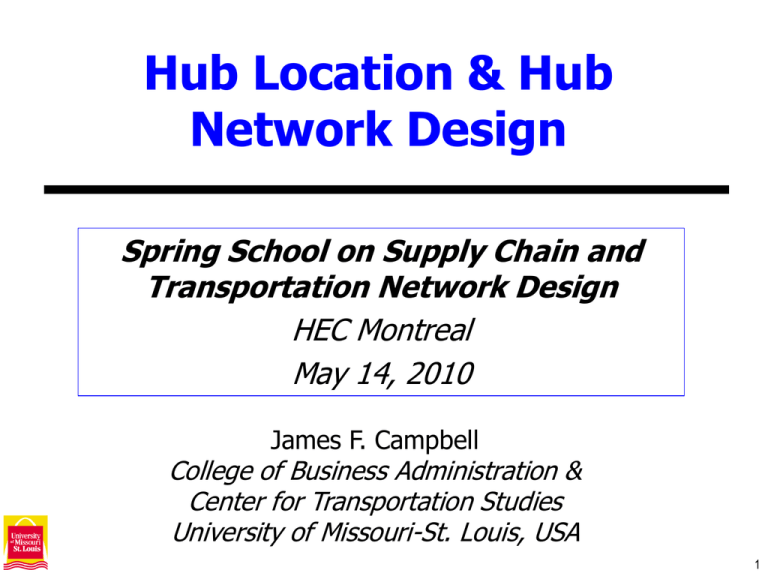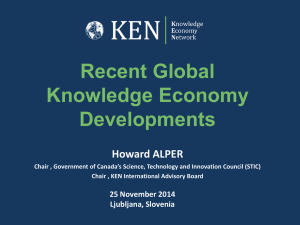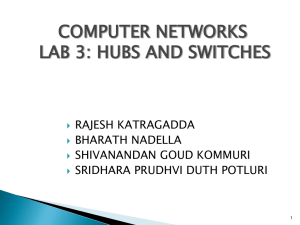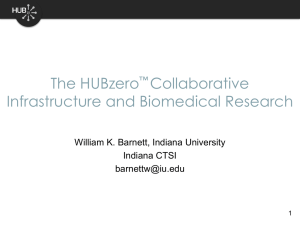New Models for Hub Location and Network Design
advertisement

Hub Location & Hub
Network Design
Spring School on Supply Chain and
Transportation Network Design
HEC Montreal
May 14, 2010
James F. Campbell
College of Business Administration &
Center for Transportation Studies
University of Missouri-St. Louis, USA
1
Outline
• Introduction, examples and background.
• “Classic” hub location models.
• Interesting “recent” research.
I.
Better solutions for classic models.
II. More realistic and/or complex problems
III. Dynamic hub location.
IV. Models with stochasticity.
V.
Competition.
VI. Data sets.
• Conclusions.
2
Design a Network to Serve 32 Cities
32 demand points (origins and destinations)
32*31/2 = 496 direct connections
3
One Hub
Access arc connect non-hubs to hubs
Single hub: Provides a
switching, sorting and
connecting (SSC) function.
Hub networks concentrate flows to exploit
economies of scale in transportation.
4
Two Hubs and One Hub Arc
Multiple Allocation
1 hub arc & 2 connected hubs:
Hubs also provide a consolidation
and break-bulk (CB) function.
Flows are further concentrated on hub arcs.
5
Multiple Allocation Four Hub Median
4 fully connected hubs
38 access arcs
6
Single Allocation Four Hub Median
4 fully connected hubs
28 access arcs
7
Multiple Hubs and Hub Arcs
8
Final Network
6 connected hubs,
1 isolated hub and
8 hub arcs
9
Hub Networks
• Allow efficient “many-to-many” transportation:
- Require fewer arcs and concentrate flows to exploit
transportation economies of scale.
• Hub arcs provide reduced cost transportation between
two hubs (usually with larger vehicles).
- Cost: i k m j : Cijkm = cik + ckm + cmj
j
- Distance: i k m j = dik + dkm + dmj
i
• Hub nodes provide:
m
k
- Sorting, switching and connection.
- Consolidation/break-bulk to access reduced cost hub arcs.
10
Hub Location Applications
• Passenger and Freight Airlines:
- Hubs are consolidation airports and/or
sorting centers.
- Non-hubs are feeder airports.
• Trucking:
- LTL hubs are consolidation/break-bulk terminals.
- Truckload hubs are relay points to change drivers/tractors.
- Non-hubs are end-of-line terminals.
• Postal operations:
- Hubs are sorting centers; non-hubs are regional post offices.
• Public transit:
- Hubs are subway/light-rail stations.
- Non-hubs are bus stations or patron o/d’s.
• Computer & telecom networks.
11
Hub Location Motivation
• Deregulation of transportation in USA:
- Airlines (1978).
- Trucking (1980).
• Express delivery industry (Federal Express began
in 1973).
- Federal Express experiences:
• Developed ILP models in ~1978 to evaluate 1 super-hub
vs. 4 hubs.
• Used OR models in mid-1970s to evaluate adding
“bypass hubs” to handle increasing demand.
• Large telecommunications networks.
12
Hub Location Research
• Strategic location of hubs and design of hub
networks.
- Not service network design, telecom, or continuous
location research.
• Began in 1980’s in diverse fields:
- Geography, Transportation, OR/MS, Location theory,
Telecommunications, Network design, Regional science,
Spatial interaction theory, etc.
• Builds on developments in “regular” facility location
modeling.
13
Hub Location Foundations
• First hub publications: Morton O’Kelly (1985-1987):
- Transportation Science, Geographical Analysis, EJOR:
• First math formulation (quadratic IP).
• 2 simple heuristics for locating 2-4 hubs with CAB data set.
- Focus on single allocation and schedule delay.
• Continuous approximation models for many-tomany transportation.
- Built on work with GM by Daganzo, Newell, Hall, Burns,
etc. in 1980s.
- Daganzo, 1987, “The break-bulk role terminals in manyto-many logistics networks”, Operations Research.
• Considered origin-hub-hub-destination, but without
discounted inter-hub transportation.
14
Hub Location & Network Design
Given:
- Network G=(V,E)
- Set of origin-destination flows, Wij
- Discount factor for hub arcs, 0<<1
Design a minimum cost network with hub nodes
and hub arcs to satisfy demand Wij.
Select hub nodes and hub arcs.
Assign each non-hub node to hubs.
15
Traditional Discrete Location Models
• Demand occurs at discrete points.
• Demand points are assigned to the closest (least
cost) facility.
• Objective is related to the distance or cost between
the facilities and demand points.
• “Classic” problems:
- p-median (pMP): Minimize the total transportation cost (demand
-
weighted total distance).
Uncapacitated facility location problem (UFLP): Minimize the sum of
fixed facility and transportation costs.
p-center: Minimize the maximum distance to a customer.
Set Covering: Minimize the # of facilities to cover all customers.
Maximum covering: Maximize the covered demand for a given
number of facilities (or given budget).
16
Discrete Hub Location Models
• Demand is flows between origins and destinations.
• Non-hubs can be allocated to multiple hubs.
• Objective is usually related to the distance or cost for
flows (origin-hub-hub-destination).
- Usually, all flows are routed via at least one hub.
• Analogous “classic” hub problems:
- p-hub median (pMP): Minimize the total transportation cost
-
(demand weighted total distance).
Uncapacitated hub location problem (UHLP): Minimize the sum of
fixed hub and transportation costs.
p-hub center: Minimize the maximum distance to a customer.
Hub Covering: Minimize the # of hubs to cover all customers.
Maximum covering: Maximize the covered demand for a given
number of hubs (or given budget).
17
Hub Location Research
• Very rich source of problems - theoretical and
practical.
• Problems are hard!!
• A wide range of exact and heuristic solution
approaches are in use.
• Many extensions: Capacities, fixed
costs for hubs and arcs, congestion,
hierarchies, inter-hub and access
network topologies, competition,
etc.
• Many areas still awaiting good
research.
18
Hub Location Literature
• Early hub location surveys/reviews:
- Campbell, 1994, Studies in Locational Analysis.
23 transportation and 9 telecom references.
- O’Kelly and Miller, 1994, Journal of Transport Geography.
- Campbell, 1994, “Integer programming formulations of
discrete hub location problems”, EJOR.
- Klincewicz, 1998, Location Science.
• Recent surveys:
- Campbell, Ernst and Krishnamoorthy, 2002, in Facility
Location: Applications and Theory.
- Alumur and Kara, 2008, EJOR (106 references).
- Computers & Operations Research , 2009, vol. 36.
• Much recent and current research…
19
Hub Median Model
• p-Hub Median: Locate p fully interconnected hubs
to minimize the total transportation cost.
• Assume:
(1) Every o-d path visits at least 1 hub.
(2) Inter-hub cost per unit flow is discounted using .
3 Hub Median
Optimal Solution
Boston
Chicago
Cleveland
Dallas
20
Hub Median Formulations
• Cost: i k m j : χcik + ckm + δcmj
i
• Single allocation:
transfer
k
j
m
Zik= 1 if node i is allocated to a hub at k ; 0 otherwise
Zkk= 1 if node k is a hub; 0 otherwise
Min
Subject to
Wij
cik Z ik
i, j
k
k
ckm Z ik Z jm
c jm Z jm
m
m
Z (n p 1)Z k Link flows and hubs
Z ik 1 i
Serve all o-d flows
k
ik
kk
i
Z
kk
p
Use p hubs
k
Z ik {0,1} i, k
21
Hub Median Formulations
• Multiple allocation: 4 subscripted “path” variables
Xijkm= fraction of flow that travels i-k-m-j
Hk = 1 if node k is a hub; 0 otherwise
Cost: i k m j : Cijkm = χcik + ckm + δcmj
Min
Subject to
(W
ij
i j
W ji )
j
C
k
X 1
Hk p
k
X
( X
ijkm
k
ijkm X ijkm
m
i, j , i j
Serve all o-d flows
m
ijkk
Use p hubs
ijkm
X ijmk ) H k
i, j, k , i j
Link flows & hubs
mk
X ijkm 0 i, j, k , m, i j
H k 0,1
k
22
Hub Median Formulations
• Multiple allocation: 3 subscripted “flow” variables
i
transfer
Zik
k
Y ikm
m
X imj
j
Zik= flow from origin i to hub k
Y ikm= flow originating at i from hub k to hub m
X imj= flow originating at i from hub m to destination j
Min
cik Z ik
i
k
k
m
i
ckmYkm
m
j
i
cmj X mj
23
Hub Median Formulations
• Multiple allocation – 3 subscripted “flow” variables
Min
Subject to
cik Z ik
k
i
k
m
Z W
ik
m
j
j
i
cmj X mj
i
ij
k
i
ckmYkm
Serve all o-d flows
i
X mj
Wij
i, j
m
Hk p
k
Y
i
km
m
Use p hubs
X Y
i
kj
j
i
mk
Z ik 0
i, k
m
W i, k
X mji H m W ij m, j
Z ik H k
ij
j
i
Flow balance
Link flows & hubs
i
H k 0,1 k
i
i
Zik , Ykm
, X mj
0
i, j, k , m
24
Hub Center and Hub Covering
• Introduced as analogues of “regular” facility center and
covering problems…but notion of covering is different.
• Campbell (EJOR 1994) provided 3 types of
centers/covering:
- Maximum cost/distance for any o-d pair
- Maximum cost /distance for any single link in an o-d path.
- Maximum cost/distance between an o/d and a hub.
i
transfer
k
j
m
• Much recent attention:
- Ernst, Hamacher, Jiang, Krishnamoorthy, and Woeginger,
2009, “Uncapacitated single and multiple allocation p-hub
center problems”, Computers & OR
25
Hub Center Formulation
• Xik = 1 if node i is allocated to hub k, and 0 otherwise
• Xkk = 1 node k is a hub
z is the maximum transportation cost between all o–d pairs.
rk = “radius” of hub k (maximum distance/cost between hub k and
the nodes allocated to it).
Min
Subject to
z
X
ik
1 i
k
X ik X kk
X
kk
i, k
p
k
rk cik X ik i, k
z rk rm ckm k m
X ik {0,1} i, k
Serve all o-d flows
Link flows & hubs
Use p hubs
Hub radius
Objective
k
26
Hub Location Themes
I. Better solution algorithms for “classic” problems.
II. More realistic and/or complex problems.
- More general topologies for inter-hub network and access
network.
- Objectives with cost + service.
- Other: multiple capacities, bicriteria models, etc.
III. Dynamic hub location.
IV. Models with stochasticity.
V. Competition.
VI. Data sets.
27
I. Better solutions for “classic” problems
• Improved formulations lead to better solutions and
solving larger problems…
Hamacher, Labbé, Nickel, and Sonneborn, 2004 “Adapting
polyhedral properties from facility to hub location
problems”, Discrete Applied Mathematics.
Marín, Cánovas, and Landete, 2006, “New formulations for
the uncapacitated multiple allocation hub location
problem”, EJOR.
- Uses preprocessing and polyhedral results to develop tighter
formulations.
- Compares several formulations.
28
Better solutions for “classic” problems
• Contreras, Cordeau, and Laporte, 2010, “Benders
decomposition for large-scale uncapacitated hub location”.
- Exact, sophisticated solution algorithm for UMAHLP.
- Solves very large problems with up to 500 nodes (250,000
commodities).
- ~2/3 solved to optimality in average ~8.6 hours.
• Contreras, Díaz, and Fernández, 2010, “Branch and price for
large scale capacitated hub location problems with single
assignment”, INFORMS Journal on Computing.
- Single allocation capacitated hub location problem.
- Solves largest problems to date to optimality (200 nodes) up to
12.5 hrs.
- Lagrangean relaxation and column generation and branch and
price.
29
II. More Realistic and/or Complex Problems
• More general topologies for inter-hub network and
access network.
- Inter-hub network: Trees, incomplete hub networks, isolated
hubs, etc.
- Access network: “Stopovers”, “feeders”, routes, etc.
• Better handling of economies of scale.
- Flow dependent discounts, flow thresholds, etc.
- Restricted inter-hub networks.
• Objectives with cost + service.
• Others: multiple capacities, bicriteria models, etc.
30
Weaknesses of “Classic” Hub Models
• Hub center and hub covering models:
- Not well motivated by real-world systems.
- Ignore costs: Discounting travel distance or
time while ignoring costs seems “odd”.
• Hub median (and UHLP) models:
- Assume fully interconnected hubs.
- Assume a flow-independent cost discount on
all hub arcs.
- Ignore travel times and distances.
31
Hub Median Model
• p-Hub Median: Locate p fully interconnected hubs
to minimize the total transportation cost.
- Hub median and related models do not accurately model
economies of scale.
- All hub-hub flows are discounted (even if small) and no access
arc flows are discounted (even if large)!
3 Hub Median
Optimal Solution
Boston
Chicago
Cleveland
Dallas
low flows on hub arcs
32
Better Handling of Economies of Scale
• Flow dependent discounts: Approximate a non-linear
discounts by a piece-wise linear concave function.
- O’Kelly and Bryan, 1998, Trans. Res. B.
- Bryan, 1998, Geographical Analysis.
- Kimms, 2006, Perspectives on Operations
Research.
• More general topologies for inter-hub network and
access network
- “Tree of hubs”: Contreras, Fernández and Marín, 2010, EJOR.
- “Incomplete” hub networks: Alumur and Kara, 2009,
Transportation Research B
- Hub arc models: Campbell, Ernst, and Krishnamoorthy, 2005,
Management Science.
33
Hub Arc Model
• Hub arc perspective: Locate q hub arcs rather than p
fully connected hub nodes.
- Endpoints of hub arcs are hub nodes.
• Hub Arc Location Problem: Locate q hub arcs to
minimize the total transportation cost.
q hub arcs and ≤2q hubs.
Assume as in the hub median model that:
• Every o-d path visits at least 1 hub.
• Cost per unit flow is discounted on q hub arcs using .
• Each path has at most 3 arcs and one hub arc (origin-hubhub-destination): model HAL1.
34
Hub Median and Hub Arc Location
Hub Median
p=3
3 hubs &
3 hub arcs
Hub Arc Location
q=3
5 hubs &
3 hub arcs
35
Time Definite Hub Arc Location
• Combine service level (travel time) constraints with cost
minimization to model time definite transportation.
• Motivation: Time definite trucking:
- 1 to 4 day very reliable scheduled service between terminals.
- Air freight service by truck!
Dest
ATL
JFK
MIA
ORD
SEA
•
Transit
Distance Days
575
2
982
2
1230
3
308
1
2087
4
Drop-off
at STL
22:00
22:00
22:00
22:00
22:00
Pickup
at Dest
7:00
9:00
8:00
9:00
8:30
Campbell, 2009, “Hub location for time definite transportation”,
Computers & OR.
36
Service Levels
• Limit the travel distance via the hub network to ensure
the schedule (high service level) can be met with
ground transport.
Direct o-d Distance
0 - 400 miles
400 - 1000 miles
1000 - 1800 miles
High Service Level
Max Travel Distance
600 miles
1200 miles
2000 miles
• Problems with High service levels (High SL) have
reduced sizes, since long paths are not feasible.
• Formulate as MIP and solve via CPLEX 10.1.1.
37
Time Definite Hub Arc Solutions for CAB
=0.2, p=10, and q=5
Low SL solution - 9 hubs!
Medium SL solution - 9 hubs!
High SL solution - 10 hubs
38
Time Definite Hub Locations
• High service levels make problems “easier”.
• High service levels “force” some hub locations.
• Good hub cities:
- Large origins and destinations.
• Chicago, New York, Los Angeles.
- Large isolated cities near the perimeter.
• Miami, Seattle.
- Some centrally located cities.
• Kansas City, Cleveland.
• Poor hub cities:
- Medium or small cities near large origins & destinations.
• Tampa.
39
Models with Congestion
Elhedhli and Wu, 2010, “A Lagrangean heuristic for huband-spoke system design with capacity selection and
congestion”, INFORMS Journal on Computing.
- Single allocation.
- Minimize sum of transportation cost, fixed cost and congestion
“cost”.
- Congestion at hub k:
W Z
Congestion
Capacity W Z
ij ik
i
j
k
k
ij ik
i
j
- Uses multiple capacity levels.
- Solves small problems up to 4 hubs and 25 nodes to
within 1% of optimality.
40
Another Model with Congestion
Koksalan and Soylu, 2010, “Bicriteria p-hub location
problems and evolutionary algorithms”, INFORMS
Journal on Computing.
- Two multiple allocation bicriteria uncapacitated p-HMP models.
• Model 1: Minimize total transportation cost and minimize total
collection and distribution cost.
• Model 2: Minimize total transportation cost and minimize maximum
delay at a hub.
- Delay (congestion) at hub k:
Congestionk
Wij X ijkm
i
j
m
Capacityk
- Solves with “favorable weight based evolutionary
algorithm”.
41
III. Dynamic Hub Location
How should a hub network respond to changing demand??
Contreras, Cordeau, Laporte, 2010, “The dynamic hub
location problem”, Transportation Science.
- Multiple allocation, fully interconnected hubs.
- Dynamic (multi-period) uncapacitated hub location with up to
10 time periods.
- In each period, adds new o-d pairs (commodities) and increase
or decrease the flow for existing o-d pairs.
- Hubs can be added, relocated or removed.
- Solves up to 100 nodes and 10 time periods with branch and
bound with Langrangean relaxation.
42
Isolated Hubs
• Isolated hubs are not endpoints of hub arcs.
- Provide only a switching, sorting, connecting function; not a
consolidation/break-bulk function.
- Give flexibility to respond to expanding demand with
incremental steps.
• How can isolated hubs be used, especially in response
to increasing demand in a fixed region and demand in
an expanding region.
Campbell, 2010, “Designing Hub Networks with
Connected and Isolated Hubs”, HICSS 43
presentation.
43
Hub Arc Location with Isolated Hubs
• Locate q hub arcs with p hubs to minimize the
total transportation cost.
If p>2q there will be isolated hubs; When p2q isolated
hubs may provide lower costs.
Each non-hub is connected to one or more hubs.
Key assumptions:
1. Every o-d path visits at least 1 hub.
2. Hub arc cost per unit flow is discounted
using .
3. Each path has at most 3 arcs and one hub
arc: origin-hub-hub-destination.
Cost: i-k-m-j = d ik d km d mj
44
Hub Network Expansion
No SL, =0.6
# of hubs , # of hub arcs, # isolated hubs
Transportation Cost
Add a hub arc between
existing hubs
Add a new isolated hub
3, 3, 0
949.2
3, 2, 0
965.2
6, 6, 0
803.5
4, 3, 1
890.6
4, 2, 1
906.6
Start with
a 3-hub
optimal
solution
5, 4, 1
843.2
5, 3, 1
859.1
5, 2, 2
875.7
6, 5, 1
812.0
6, 4, 2
825.7
6, 3, 2
841.6
6, 2, 3
862.7
7, 5, 2
801.7
7, 4, 3
815.3
7, 3, 3
831.2
45
Geographic Expansion
q=3 hub arcs
Optimal with no west-coast
cities, p=4
Add 5
WestCoast
cities
Allow 1 Isolated Hub
1 isolated hub, Cost=914
No isolated hubs, Cost=1085
Allow hub arcs to be moved
1 isolated hub, Cost=864
46
Findings for Isolated Hubs
• Isolated hubs are useful to respond efficiently to:
- an expanding service region and
- an increasing intensity of demand.
• Adding isolated hubs may be a more cost effective than
adding connected hubs (and hub arcs).
• Isolated hubs seem most useful in networks having:
few hub arcs, small values (more incentive for
consolidation), and/or high service levels.
• With expansion, the same hubs are often optimal – but
the roles change from isolated to connected.
47
IV. Models with Stochasticity
How should stochasticity be incorporated??
Lium, Crainic and Wallace, 2009, “A study of demand
stochasticity in service network design, Transportation Science.
- Does not assume particular topology and shows hub-and-spoke
structures arise due to uncertainty.
“consolidation in hub-and-spoke networks takes place not necessarily
because of economy of scale or other similar volume-related reasons,
but as a result of the need to hedge against uncertainty”
Sim, Lowe and Thomas, 2009, “The stochastic p-hub center
problem with service-level constraint”, Computers & OR.
- Single assignment hub covering where the travel time Tij is
normally distributed with a given mean and standard deviation.
- Locate p hubs to minimize so that the probability is at least
that the total travel time along the path i→k→l→j is at most .
48
V. Competitive Hub Location
• Suppose two firms develop hub networks to compete for
customers.
• Sequential location - Maximum capture problem:
- Marianov, Serra and ReVelle, 1999, “Location of hubs in a
competitive environment”, EJOR.
- Eiselt and Marianov, 2009, “A conditional p-hub location
problem with attraction functions”, Computers & OR.
• Stackelberg hub problems:
- Sasaki and Fukushima, 2001, “Stackelberg hub location
problem”, Journal of Operations Research Society of Japan.
- Sasaki, 2005, “Hub network design model in a competitive
environment with flow threshold”, Journal of Operations
Research Society of Japan.
49
Stackelberg Hub Arc Location
• Use revenue maximizing hub arc models with Stackelberg
competition.
• Two competitors (a leader and follower) in a market.
- The leader first optimally locates its own qA hub arcs, knowing
that the follower will later locate its own hub arcs.
- The follower optimally locates its own qB hub arcs after the
leader, knowing the leader’s hub arc locations.
• Assume:
- Competitors cannot share hubs.
- Customers travel via the lowest cost path in each network.
• The objective is to find an optimal solution for the leader given the follower will subsequently design its optimal hub
arc network.
50
How to Allocate Customers among
Competitors?
• Customers are allocated between competitors based on
the service disutility, which may depend on many
factors:
- Fares/rates, travel times, departure and arrival times,
frequencies, customer loyalty programs, etc.
• For a strategic location model, we assume revenues
(fares/rates) are the same for each competitor.
• We focus on disutility measures in terms of travel
distance (time) and travel cost.
• Key factors may differ between passenger and freight
transportation.
51
Cost & Service
• For freight, a shipper does not care about the path
as long as the freight arrives “on time”.
- Often pick up at end of day and deliver at the
beginning of a future day.
- Allocate between competitors based on relative cost
of service.
• Passengers are more sensitive to the total travel
time (though longer trips allow more circuity).
- Allocate between competitors based on relative
service (travel time or distance).
52
Distance Ratio and Cost Ratio
Distance ratio (passengers):
DijA: The distance for the trip from i to j that achieves the minimum
cost for Firm A.
DijB : The distance for the trip from i to j that achieves the minimum
cost for Firm B.
j
DRij =(DijA–DijB) /(DijA +DijB)
i
l
k
Cost ratio (freight):
CijA : The minimum cost for the trip from i to j for Firm A.
CijB : The minimum cost for the trip from i to j for Firm B.
CRij =(CijA–CijB) /(CijA +CijB)
As DijA (or CijA) 0, DRij (or CRij) -1, and Firm A captures all revenue.
53
5-level Step Function for Customer Allocation
Fraction of demand
captured by Firm A
ΦijA(xA,xB) = fraction of
demand captured by Firm A
CRij or Drij
–r1
–r1 to –r2
–r2 to r2
r2 to r1
> r1
ΦijA(xA,xB)
100%
75%
50%
25%
0%
r1 and r2 determine selectivity level of customers.
r1 = r2 = 0 is an “all-or-nothing” allocation.
r1 = 0.75, r2 = 0.50 is insensitive to differences.
54
Notation
• Given:
-
V = set of demand nodes, V (|V |=n)
Wij = set of origin-destination flows
Fij = set of origin-destination revenues (e.g. airfares)
dij = distance between i and j
Cijkl = unit cost for the path i k l j = dik+dkl+dlj s
= cost discount factor for hub arcs, 0<≤1.
Ykli
• Decision variables:
i
k
l
j
- xijklA (xijklB) = flow for i k l j for Firm A (B)
- yklA (yklB) = 1 if there is a hub arc k–l for Firm A (B)
- zkA (zkB) = 1 if there is a hub at city k for Firm A (B)
55
HALCE-B (Firm B’s problem)
Maximize FijWij (1 ijA ( x A , x B ))
iV j i
s.t.
Maximize B’s total
revenue
B
q
,
y
kl
B
k ,l
z 1 z
B
k
A
k
k V ,
z y y
B
kl
B
k
l k
xijkl y kl
B
x
B
ijkk
B
z
B
k
B
x
ijkl
1
l k
B
lk
k V ,
Hub arcs
& hubs
i, j , k , l V , j i, l k ,
i, j , k V , j i,
Network
Flow
i, j V ,
k ,l
B
B
,
,
{0,1}
y
x
z
k
kl
B
ijkl
56
HALCE-A (Firm A’s Problem)
Maximize FijWijijA ( x A , x B )
Maximize A’s total
revenue
iV j i
s.t.
A
A
y
q
,
kl
kV l k
z kA yklA ylkA
l k
x
A
ijkl
l k
y klA
i, j , k , l V , j i, l k ,
xijkk z kA
i, j , k V , j i,
A
x
A
ijkl
k V ,
Hub arcs
& hubs
1
i, j V ,
Network
Flow
k ,l
A
xijkl
, yklA , z kA {0,1},
[ x , y , z ] ( x , y , z ).
B
B
B
A
A
A
Firm B finds an
optimal solution 57
Optimal Solution Algorithm
• “Smart” enumeration algorithm:
Enumerate all of Firm A’s sets of qA hub arcs.
For each set of Firm A’s hub arcs, use bounding tests to
enumerate only some of Firm B’s qB hub arcs and only
some OD pairs.
• Bounding tests are effective and allow problems with
up to 3 hub arcs for Firm A and Firm B to be solved to
optimality.
• But we would still like to solve larger problems…
58
540 Problem Scenarios with CAB data
• 2 OD revenue sets:
- airfare : IATA Y class airfares
2500
- distance : direct OD distance
- low: (r1, r2)=(0.75,0.25)
- medium: (r1, r2)=(0.083,0.015)
Airfare (USD)
• 3 levels of customer selectivity:
2000
- high: (r1, r2)=(0,0) (“all-or-nothing”)
• 2 Customer allocation schemes:
1500
1000
500
0
0
1000
2000
3000
Direct Distance (miles)
- Distance ratio allocation (passenger)
- Cost ratio allocation (freight)
• 5 values of : 0.2, 0.4, 0.6, 0.8, 1.0
• Up to 3 hub arcs for Firms A and B.
59
Results: High Customer Selectivity
Distance ratio allocation
qA=qB=2, =0.6
Revenue = airfare
Revenue = distance
Red lines: Firm A’s optimal solution
Blue lines: Firm B’s optimal solution
60
Hub Use with Distance Ratio Allocation
92.2%
86.3%
47.0%
57.4%
47.8%
Top hub arcs for Firm A
Top hub arcs for Firm B
61
Cost Ratio vs. Distance Ratio
Revenue=distance, qA=qB=3, =0.6
Over 67% of revenues are
from paths with a hub arc.
Only 15% of revenues are
from paths with a hub arc.
Cost Ratio allocation (freight)
Firm A’s hubs=4,6,8,12,17,22
Distance ratio allocation (passengers)
Firm A’s hubs=1,4,12,14,17,22
Red lines: Firm A’s optimal solution
Blue lines: Firm B’s optimal solution
62
Findings
• The leader (Firm A) usually has an advantage, but not
always (“first entry paradox”).
• Distance ratio allocation encourages one-stop routes
(as preferred by passengers).
• Cost ratio allocation encourages more circuitous twostop routes (as in freight transportation).
• Large origins/destinations have a large advantage for
hub location.
- Peripheral cities have a geographic disadvantage for hub
location.
• Though the optimal hub arcs vary considerably, the
competitors generally use the same optimal hub nodes.
63
Competitive Model Conclusions
• There are some interesting differences between the
leader’s and follower’s strategies:
- The leader tends to use fewer hubs more intensively, but the
follower performs about as well in many cases!
- The leader tends to capture the higher revenue customers,
while the follower captures more, but less valuable, customers.
• Optimal network design can be very sensitive to the
customer allocation mechanisms.
64
VI. Hub Location Data Sets
• Much work has been done with only a few
data sets:
- CAB25: 25 cities in US.
- AP: up to 200 postal locations in Sydney, Australia.
- “Turkish data”: 81 nodes in Turkey
• What should alpha be?
65
CAB25 Data Set
• 25 US cities with symmetric flows based on air passenger traffic
in 1970.
• No flow from a node to itself (Wii=0).
• Subsets are alphabetical.
1500
1100
700
COG
1-median
300
-100 0
400
800
1200
1600
2000
2400
2800
66
AP Data Sets
• Up to 200 postal codes in Sydney with asymmetric flows of mail
from 1993(?) and given collection, transfer and distribution costs.
• 42.4% of flows (including all flows Wii) are at minimum level of
0.01 (mean flow=0.0995)
• Smaller data sets are created to be “ a reasonable approximation”
of the larger problem.
AP200
60000
AP20
60000
50000
50000
40000
40000
COG
30000
COG
30000
Median
Median
20000
20000
10000
10000
0
0
0
20000
40000
60000
0
20000
40000
60000
67
Turkish network: TR81
• 81 nodes for provinces in Turkey with asymmetric flows
generated based on populations.
• Often used with =0.9 (from interhub travel time discount).
• Smaller versions selected in various ways.
TR81
43
COG
42
1-median
41
40
39
38
37
36
26
28
30
32
34
36
38
40
42
44
68
Concentration of Demand
Cumulative Demand Curves
1
0.9
cumulative % of demand
0.8
0.7
TR81 o-d flows
0.6
CAB25 o-d flows
0.5
AP200 nodes
0.4
TR81 nodes
0.3
CAB25 nodes
0.2
AP20 nodes
0.1
0
0
0.2
0.4
0.6
0.8
1
Cumulative % of o-d pairs or nodes
69
Spatial Distribution of Demand
Cumulative Distribution of Demand
1
% of flow
0.8
0.6
CAB25
AP20
0.4
AP200
TR81
0.2
0
0
0.2
0.4
0.6
0.8
1
% of max distance from median
70
Distribution of Demand
• Optimal hub locations and hub networks reflect the
underlying distributions of flows (and aggregated
flows).
• All data sets have flows heavily concentrated in a few
large nodes.
• CAB is least centrally concentrated with large
peripheral demand centers.
• AP has concentrated demand and is least evenly
distributed over the region.
- Subsets of AP may not be as similar to each other as
“designed”.
• TR81 is most evenly distributed in space.
71
Alpha
• What is the “right” value of?
Value
Mode
Location
0.25-0.375
Truck-postal
Australia
0.7
Truck
EU
0.365
Truck-rail
EU
0.7 – 1.0
LTL
Brazil
0.4946
Truck (time
definite)
Taiwan
Reference
Ernst and Krishnamoorthy,
Location Science 1996
Limbourg and Jourquin,
Transportation Research E 2009
Limbourg and Jourquin,
Transportation Research E 2009
Cunha and Silva,
EJOR 2007
Chen, Networks and Spatial
Economics 2010
72
New Directions for Hub Location Research
• Better, more realistic models:
- Incorporate cost, service and competition.
- Model relevant costs (especially economies of scale)
more accurately.
- More complex networks with longer paths and direct
routes.
• Solve larger problems.(?)
• Link to service network design.
• Link to telecom hub location.
• Link to practice.
73
Questions?
74







